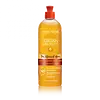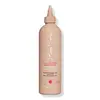What's inside
What's inside
 Key Ingredients
Key Ingredients

 Benefits
Benefits

 Concerns
Concerns

 Ingredients Side-by-side
Ingredients Side-by-side

Water
Skin ConditioningPEG-40 Castor Oil
EmulsifyingGlycerin
HumectantParfum
MaskingVinegar
Cetrimonium Chloride
AntimicrobialPanthenol
Skin ConditioningMenthyl Lactate
MaskingMenthol
MaskingIsopulegol
MaskingArgania Spinosa Kernel Oil
EmollientPropylene Glycol
HumectantCocodimonium Hydroxypropyl Hydrolyzed Keratin
Skin ConditioningRosmarinus Officinalis Leaf Extract
AntimicrobialHydrolyzed Rice Protein
Skin ConditioningTocopheryl Acetate
AntioxidantCamellia Sinensis Leaf Extract
AntimicrobialCitric Acid
BufferingTetrasodium EDTA
Polyquaternium-4
Phenoxyethanol
PreservativeSodium Benzoate
MaskingCI 19140
Cosmetic ColorantCI 16035
Cosmetic ColorantCI 42090
Cosmetic ColorantWater, PEG-40 Castor Oil, Glycerin, Parfum, Vinegar, Cetrimonium Chloride, Panthenol, Menthyl Lactate, Menthol, Isopulegol, Argania Spinosa Kernel Oil, Propylene Glycol, Cocodimonium Hydroxypropyl Hydrolyzed Keratin, Rosmarinus Officinalis Leaf Extract, Hydrolyzed Rice Protein, Tocopheryl Acetate, Camellia Sinensis Leaf Extract, Citric Acid, Tetrasodium EDTA, Polyquaternium-4, Phenoxyethanol, Sodium Benzoate, CI 19140, CI 16035, CI 42090
Water
Skin ConditioningAloe Barbadensis Leaf Juice
Skin ConditioningGlycerin
HumectantVinegar
Babassuamidopropyl Betaine
CleansingPolysorbate 20
EmulsifyingHydroxypropyl Guar
Emulsion StabilisingCocamidopropyl Betaine
CleansingCitrus Limon Peel Oil
MaskingLemongrass Oil
Citral
PerfumingMentha Piperita Oil
MaskingPhenoxyethanol
PreservativePropylene Glycol
HumectantNiacinamide
SmoothingSaccharomyces/Xylinum/Black Tea Ferment
Skin ConditioningHydroxyethylcellulose
Emulsion StabilisingSaccharomyces/Rice Ferment Filtrate
Skin ConditioningButylene Glycol
HumectantEthylhexylglycerin
Skin ConditioningPotassium Sorbate
PreservativeAnanas Sativus Fruit Extract
Skin ConditioningCamellia Sinensis Leaf Extract
AntimicrobialSodium Hydroxide
BufferingWater, Aloe Barbadensis Leaf Juice, Glycerin, Vinegar, Babassuamidopropyl Betaine, Polysorbate 20, Hydroxypropyl Guar, Cocamidopropyl Betaine, Citrus Limon Peel Oil, Lemongrass Oil, Citral, Mentha Piperita Oil, Phenoxyethanol, Propylene Glycol, Niacinamide, Saccharomyces/Xylinum/Black Tea Ferment, Hydroxyethylcellulose, Saccharomyces/Rice Ferment Filtrate, Butylene Glycol, Ethylhexylglycerin, Potassium Sorbate, Ananas Sativus Fruit Extract, Camellia Sinensis Leaf Extract, Sodium Hydroxide
Ingredients Explained
These ingredients are found in both products.
Ingredients higher up in an ingredient list are typically present in a larger amount.
Camellia Sinensis Leaf Extract is derived from the leaves of the tea plant. Black tea, green tea, and oolong tea are all harvested from this plant.
This ingredient has many skin benefits:
This ingredient contains polyphenols, a strong antioxidant. Antioxidants help fight off molecules that damage skin cells.
On top of that, the antioxidants in green tea neutralize free-radicals from the sun. This gives the skin some extra UV protection, but should not replace sunscreen.
Many components of tea have anti-inflammatory properties.
Polyphenols and L-theanine help soothe the skin and reduce irritation. The caffeine in Camellia Sinensis Leaf Extract helps calm inflamed blood vessels.
Other compounds found in tea include: Vitamin Bs, linoleic acid, magnesium, calcium, iron, and zinc.
Research has shown both drinking Camellia Sinensis Leaf Tea and applying it to the skin can help boost skin elasticity and hydration. Studies also show using tea extract may reduce sebum, or oil, production.
Learn more about Camellia Sinensis Leaf ExtractGlycerin is already naturally found in your skin. It helps moisturize and protect your skin.
A study from 2016 found glycerin to be more effective as a humectant than AHAs and hyaluronic acid.
As a humectant, it helps the skin stay hydrated by pulling moisture to your skin. The low molecular weight of glycerin allows it to pull moisture into the deeper layers of your skin.
Hydrated skin improves your skin barrier; Your skin barrier helps protect against irritants and bacteria.
Glycerin has also been found to have antimicrobial and antiviral properties. Due to these properties, glycerin is often used in wound and burn treatments.
In cosmetics, glycerin is usually derived from plants such as soybean or palm. However, it can also be sourced from animals, such as tallow or animal fat.
This ingredient is organic, colorless, odorless, and non-toxic.
Glycerin is the name for this ingredient in American English. British English uses Glycerol/Glycerine.
Learn more about GlycerinPhenoxyethanol is a preservative that has germicide, antimicrobial, and aromatic properties. Studies show that phenoxyethanol can prevent microbial growth. By itself, it has a scent that is similar to that of a rose.
It's often used in formulations along with Caprylyl Glycol to preserve the shelf life of products.
Propylene Glycol is an odorless, colorless liquid. As a humectant, it helps skin retain moisture. It also aids in delivering active ingredients.
Another role of this ingredient is preventing a product from melting or freezing. Propylene glycol also adds antimicrobrial properties to a product, elongating product lifespan.
This ingredient is considered an organic alcohol and commonly added into both cosmetics and foods.
Those with sensitive skin or conditions may develop a rash when using this ingredient.
Learn more about Propylene GlycolIn cosmetics, vinegar is often used to help adjust the pH of a product. It is also a light exfoliant. The pH of your skin is important to maintain a healthy skin barrier.
Vinegar is created by the process of double-fermentation. It is an aqueous solution consisting mostly of water and acetic acid. Typically, vinegar contains anywhere from 5-8% acetic acid.
Other components include small amounts of contains small amounts of tartaric acid and citric acid. Depending on what is used to ferment the vinegar, it can have traces of flavoring as well.
Learn more about VinegarWater. It's the most common cosmetic ingredient of all. You'll usually see it at the top of ingredient lists, meaning that it makes up the largest part of the product.
So why is it so popular? Water most often acts as a solvent - this means that it helps dissolve other ingredients into the formulation.
You'll also recognize water as that liquid we all need to stay alive. If you see this, drink a glass of water. Stay hydrated!
Learn more about Water